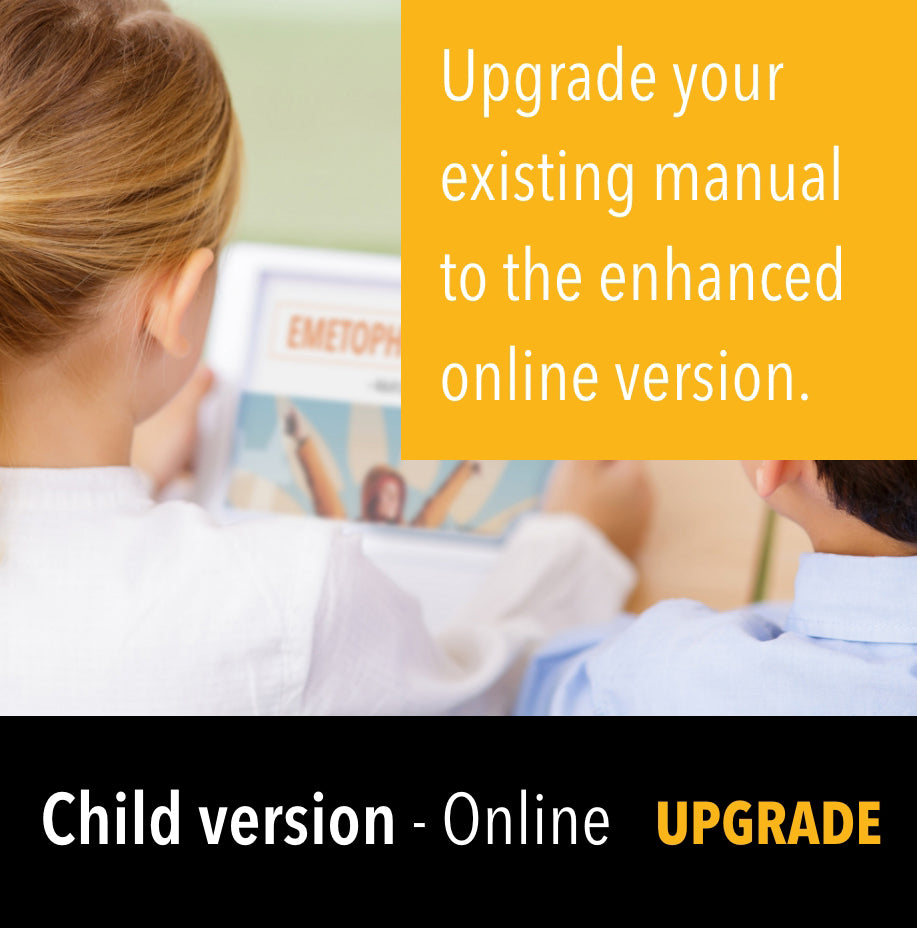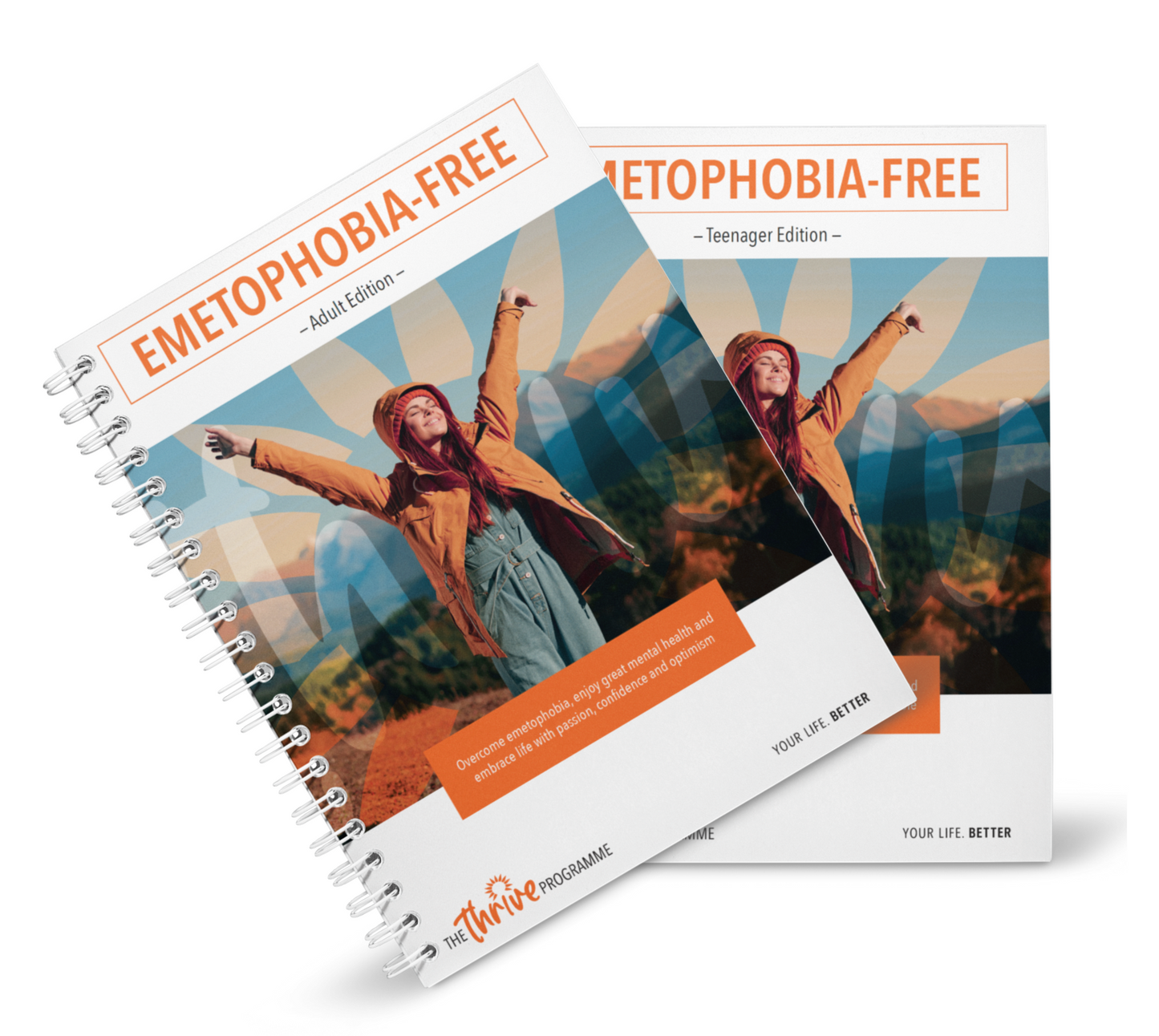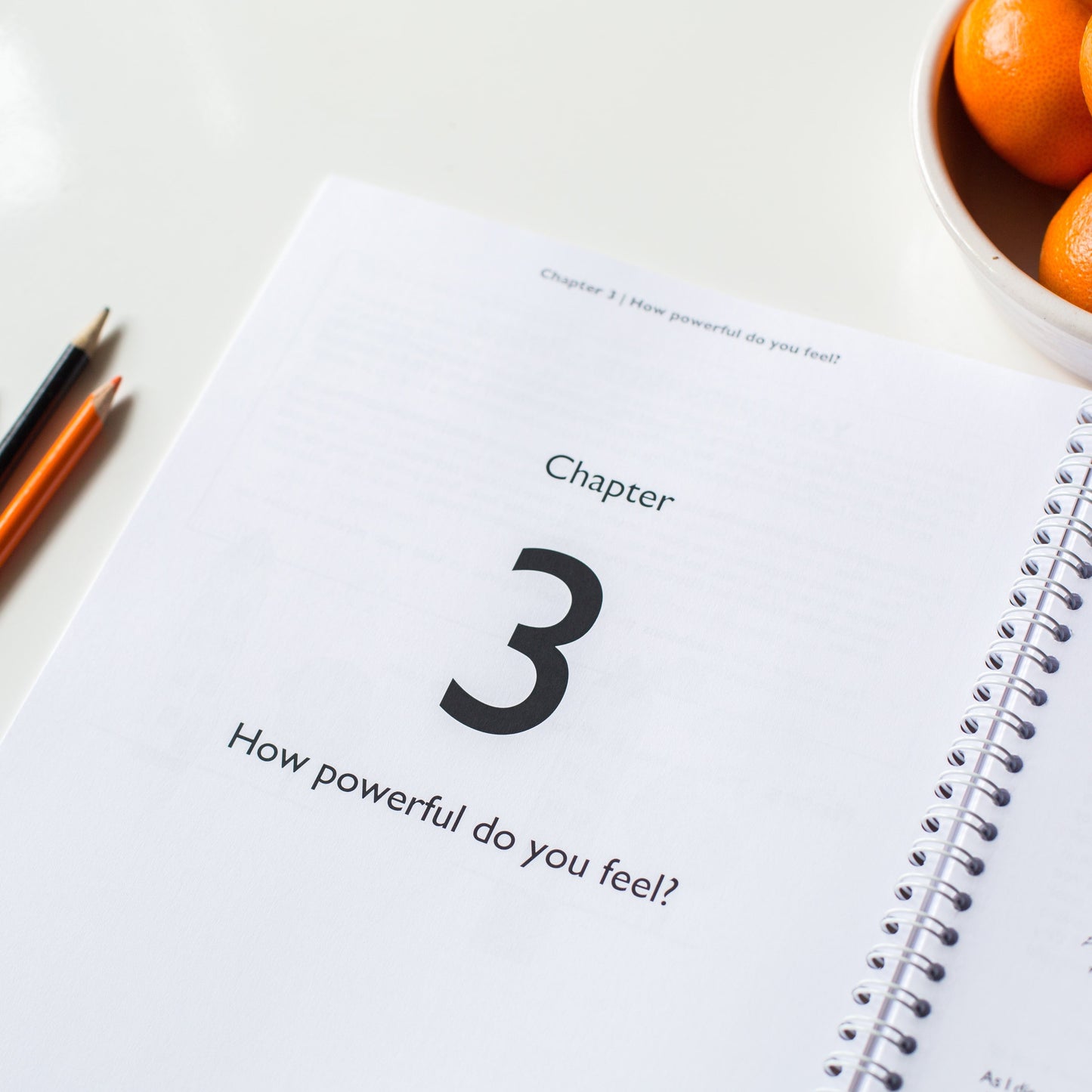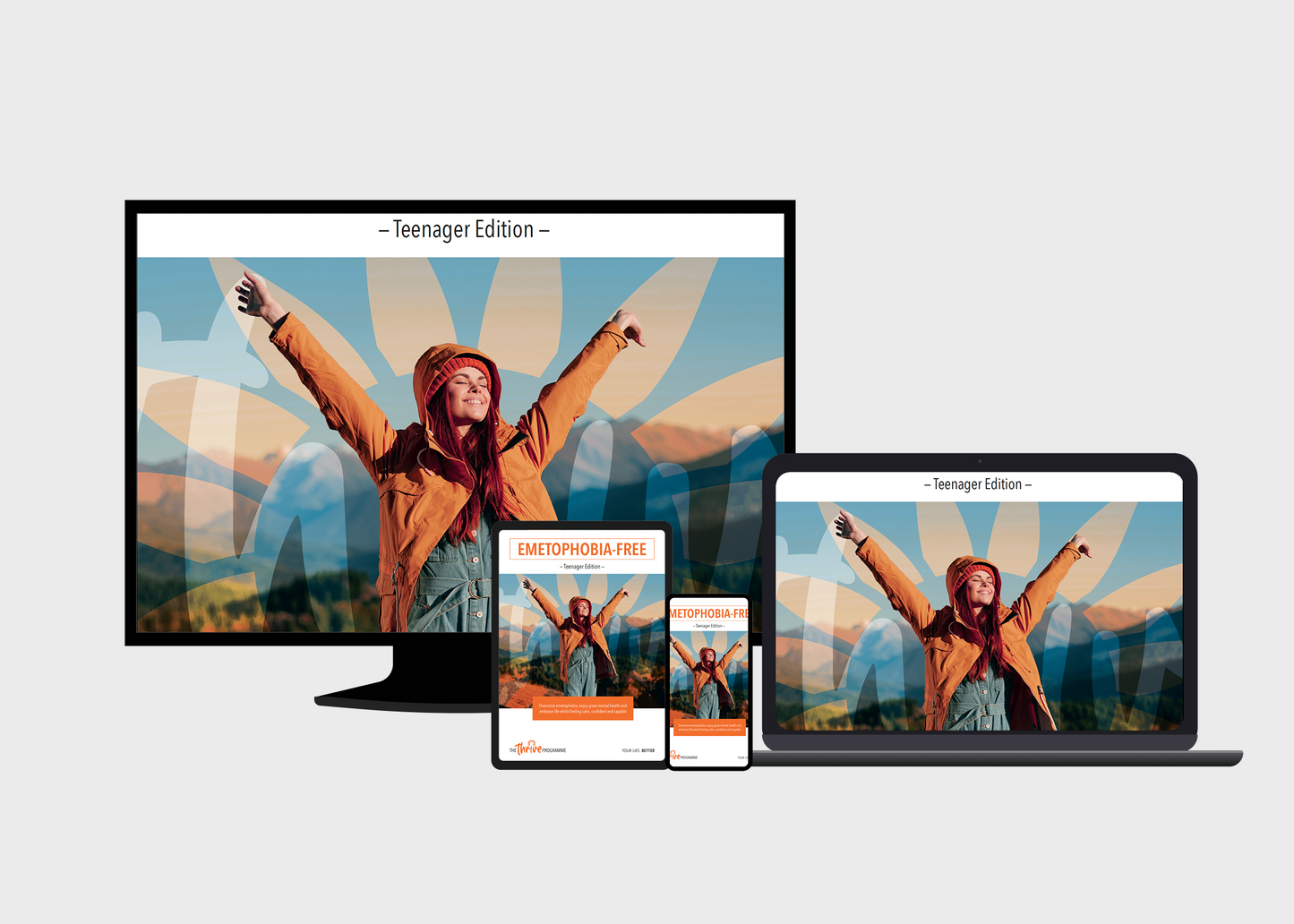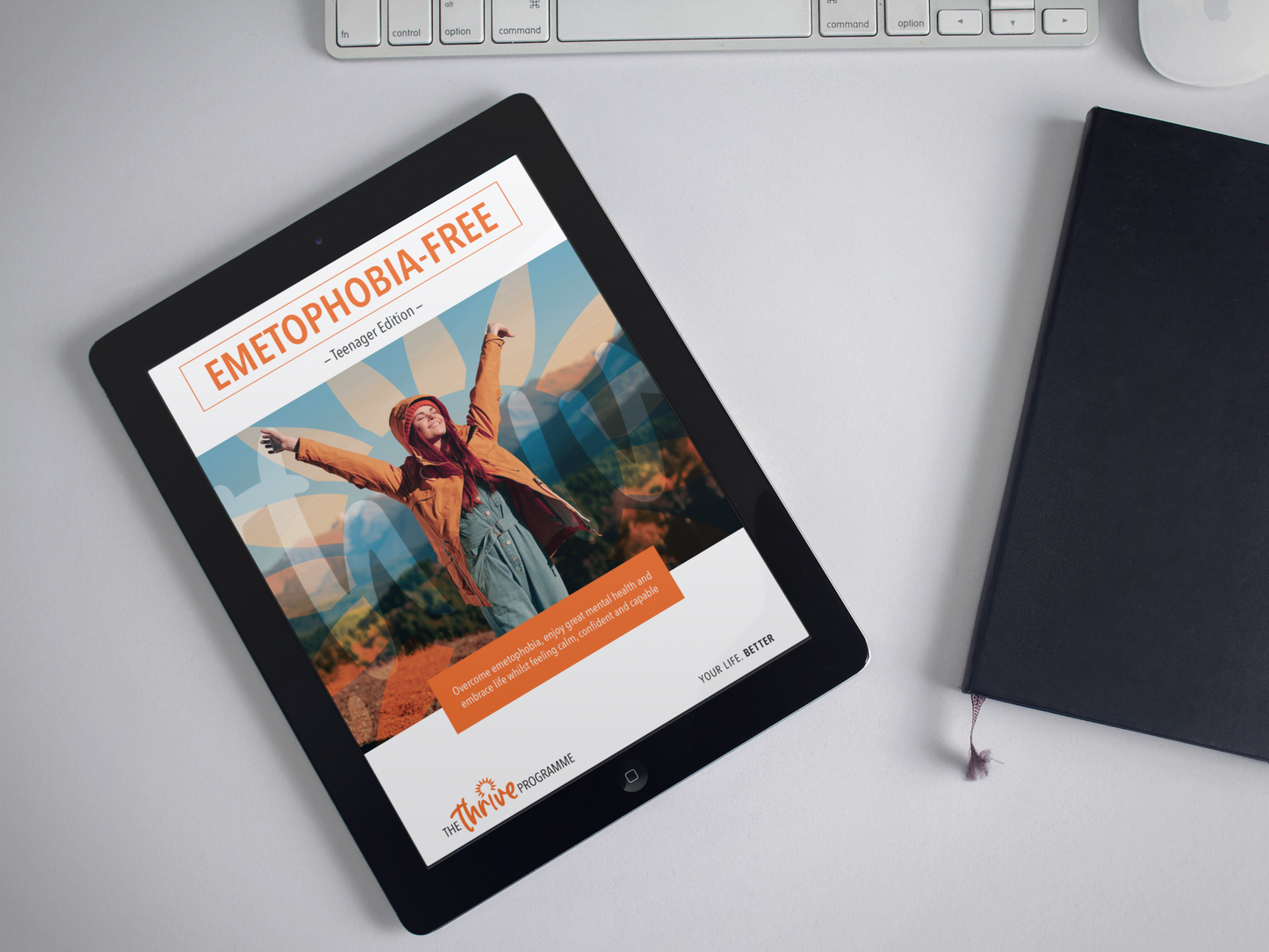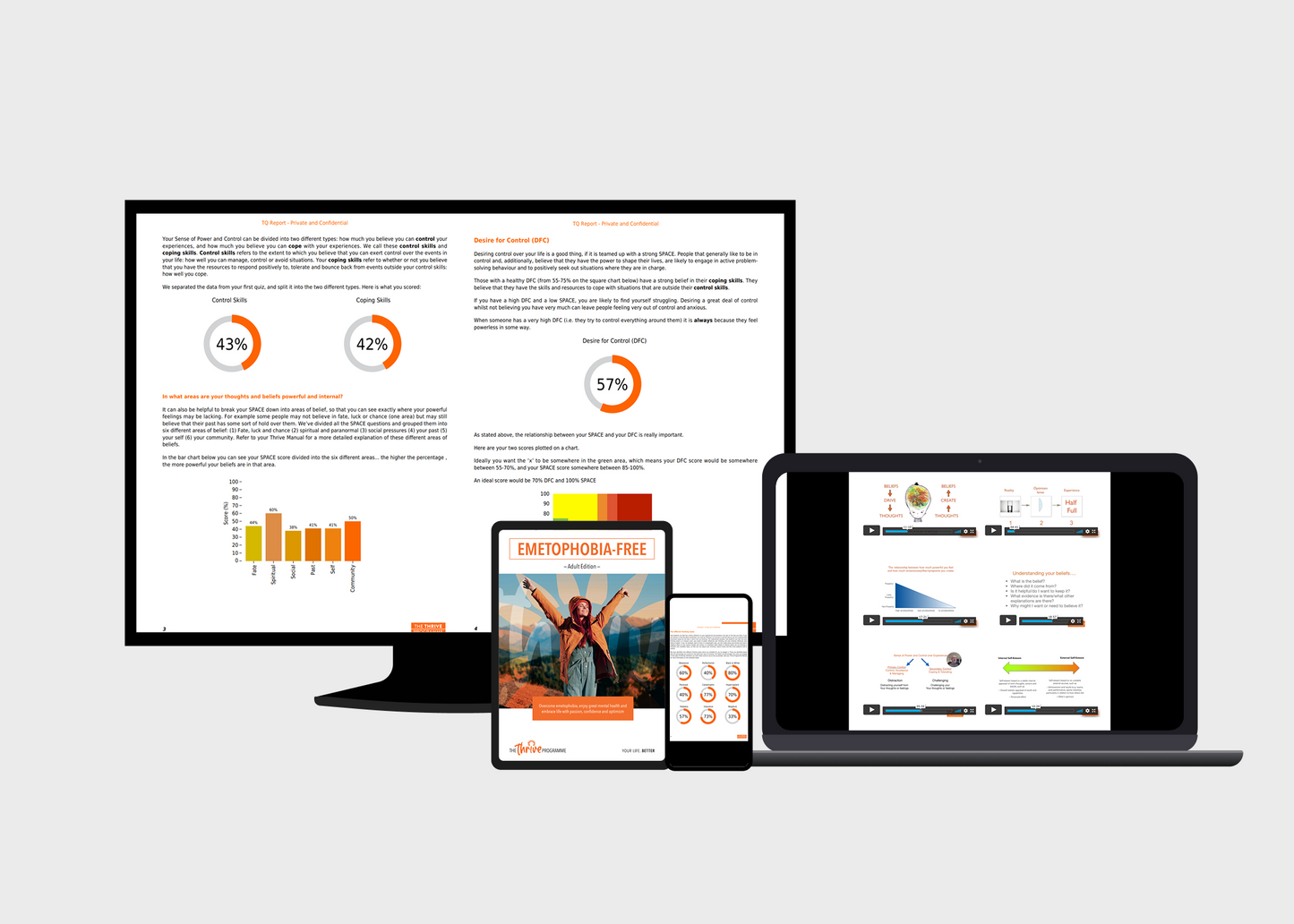The Emetophobia Programme for Children (Upgrade)
The Emetophobia Programme for Children (Upgrade)
Couldn't load pickup availability
This upgrade is for those who already own The Thrive Programme for Children but want to upgrade to the Enhanced Programme with all its extra resources.
Important: This enhanced programme is designed for both the child AND their parent/carer to complete together. The child will work through their manual alongside the adult who will work through their own adult manual (both manuals are included in the child programme). It is imperative that the adult read, learn and understand all the concepts within the programme to assist their child throughout.
Included in the programme:
- The Emetophobia-Free Programme Manual for Children in digital form
- The Emetophobia-Free Programme Manual for Adults in digital form (access details for both delivered to the purchaser’s email address within minutes)
- Free manual updates for life
- Online 20-page TQ Assessment to track your progress
- Emetophobia Quizzes throughout to help you track your progress
- 27+ support/explainer videos
- A full Q and A
- Email support from HQ
Support Videos included with this version:
*The support videos are for both the child and the parent to watch and learn together.
- Introduction to the programme – This welcome video is a brief outline of how the programme works, how to approach it and crucially, how to get the very most out of every single part of it.
- About The Emetophobia-Free Programme – This introductory video explains how the process works, how to use the videos to best effect, and how the programme itself started, with some real-life examples of our most inspiring former clients. It outlines how other mental health treatments are structured, their similarities and their shortcomings, and explains how the programme fits (or perhaps doesn’t!) into the current mental health treatment landscape.
- Understanding your Emetophobia TQ Report – This video explains all of the results from your TQ Report. Understanding what all of the graphs mean will allow you to fully appreciate where you are and therefore, where you are heading. In working hard to improve all of the section results from your TQ report, you will see that your progress is measurable and, vitally, predictable.
- Beliefs & Cognitions – This video examines our beliefs and the way we see things in more details. It looks at the huge impact our own individual filters and ‘lenses’ are in shaping how we view our reality, shows how exactly we create these lenses, and discusses related concepts like ‘cognitive bias’ and ‘inattention bias’. It explains how these different filters affect the way we view, process and react to different experiences and events. The video also examines the connection between thoughts and beliefs, particularly in relation to phobias and fears.
- SPACE v LOC - This video expands on the information within Chapter 3 of the manual, outlining the significant differences between Locus of Control (a huge factor in Emetophobia) and SPACE, the Thrive Programme’s explanation of personal control.
- Introduction to SPACE - This video introduces us to the concept of SPACE, our Sense of Power and Control over Events. It looks at how exactly we learn behaviours and thinking styles, dispelling the myth that we are born and/or stuck with certain unhelpful thinking patterns. It looks in more detail at thoughts and beliefs, and outlines experiments demonstrating how quickly just a few words can subconsciously affect our behaviours and attitudes. This video also explores the concept of ‘psychological foundations’.
- More about SPACE - This video looks in more detail at psychological foundations and the way that we process events. It explores their relationships to SPACE, to our Desire for Control and to our coping skills. It looks at different kinds of external influences, from religion and spirituality to fate, luck, horoscopes, the supernatural/paranormal, as well as social pressures and conformity. It explores how these can affect not just our SPACE, but our emotions, reactions, attitudes, and behaviours, and fuel powerlessness in areas such as obesity, addiction and smoking, health problems, emotional responses, work and relationships.
- Depth of Belief - This video focuses on how exactly we challenge our SPACE, think more internally, and change our unhelpful or limiting beliefs. It highlights not just the belief change itself, but the process and depth of belief changes. It looks at how to create stable belief changes that build a new perspective and SPACE, the importance of looking for new evidence, and examines the ‘belief wall’ tool in order to embed belief changes.
- Understanding & Internalising Beliefs - This video explains beliefs in more detail and covers how to internalise the beliefs that you hold.
- Distraction v Challenging - This video explores the differences between distracting yourself from an unhelpful thought, idea or emotion and challenging it. Where one can be unhelpful and help solidify external beliefs, the other can help us minimise our avoidance behaviours whilst also creating and maintaining new, helpful, powerful beliefs.
- Self-Esteem - This video focuses on a core part of our psychological foundations: self-esteem. It outlines what builds high, stable self-esteem, the role of our inner voice, and dispels the myth that our self-esteem is based on external factors like work, relationships, income, the past, and social life. It introduces the additional concepts of internal and external self-esteem, of a 2-week self-esteem ‘battery’, and outlines our marble analogy for positive and negative thinking and self-regard.
- Social Confidence - This video explains what social confidence is, how it is not real, but we actually create it, and outlines its psychological opposite (social anxiety). It links social confidence back to self-esteem and to SPACE, shows how it also relates to our levels of secondary control, and explains the differences between anticipatory and real-time anxiety. It explains how social anxiety links to a number of specific unhelpful thinking styles, how the behaviour is often learned and copied from a significant other, and the importance of building perspective and learning to tolerate uncomfortable emotions in order to challenge socially anxious thoughts. It also introduces key concepts including ‘diffusion of responsibility’ and ‘obedience to authority’.
- Social Confidence – Overcoming fears & phobias - This video explores how we challenge social anxiety, with particular relation to overcoming phobias, fears and performance-related anxieties. It explores the importance of managing your thinking well on a daily basis, and outlines an approach to 'preparing for, managing during, and processing after' a challenging situation or event. It examines the key role of your inner voice in building confidence and reducing anticipatory anxiety, and outlines in detail the process for doing this and managing your thinking well around difficult situations.
- Unhelpful Thinking Styles - This video explores a number of unhelpful thinking styles covered in the (identically named) chapter; Negative, Brooding/Obsessive, Paranoid, Black and White, Catastrophic, Impulsive, Perfectionist, Hypervigilant, and Learned Helplessness. It explains how each thinking style presents itself and why somebody would feel they need to use each one, and links them all back to our psychological foundations and in particular to our SPACE.
- Mind Your Language - This video explains the importance of language awareness and how the language you use reflects your thoughts, emotions and beliefs. It also outlines the significance of the language that is used, from active to passive, from helpful to unhelpful.
- The Stressometer - This video explains the stressometer, the gauge that was created to give people an explanation as to how stressed or anxious they feel. Drawing comparisons between the thoughts that you are having and the emotions (or levels of stress) that you are experiencing, this video give real insight into your thinking and how to challenge and change those thoughts and ultimately stresses.
- The Dream Technique – This video explores the amazing reset process, The Dream Technique. An acronym for the words detect, reward, escape, amend and magnify, this five step procedure is explained so that you understand exactly what to do when finding yourself in those moments when a reset is necessary
- The ABC’s of Thriving - This video is a guide for building and maintaining a thriving attitude and perspective even after finishing the programme. It outlines a simple ‘A, B, C’ process for managing your thinking and ensuring you are doing all the key basic Thrive work on a daily basis to keep yourself in a healthy and helpful headspace. It explains how and why to focus on your A (Attitude), B (Beliefs) and C’s (Control) every day, and gives an overview of how to implement each one on a daily basis to fit in easily with everyday life.
- Thinking during Blips - This specific video focuses on what happens to our thinking when we go through a blip, and explains how when we aren’t managing our thinking, our emotions can become very unpredictable and erratic. It explains that emotions don’t happen ‘to us’ but are generated 'by us'. It also explains that with the right effort and right Thrive tools, understanding what has caused your blip can then enable you to get yourself out of it quickly and predictably.
- Beliefs & why we react so quickly - This short video examines the common assumption that emotions just ‘happen’ to us quickly, in the moment, without any lead-up thinking. It looks again in more detail at the way we view and process events and experiences, and explains how our underlying beliefs and SPACE directly and predictably contribute to exactly what emotions and reactions we create in the moment, even if at the time they might SEEM spontaneous and out of our control.
- PACE – This video explains the idea of persistent and continuous effort, which is a requirement of learning how to thrive. Applying yourself with effort on a regular, daily basis is a must and, in doing so, building new solid beliefs to that effect are an excellent by-product. It outlines that seeing the process as a journey, where each step is another step toward your destination.
- Recognising when to take Action – This video explains the idea of persistent and continuous effort, which is a requirement of learning how to thrive. Applying yourself with effort on a regular, daily basis is a must and, in doing so, building new solid beliefs to that effect are an excellent by-product. It outlines that seeing the process as a journey, where each step is another step toward your destination
- Plus 5 Top Tip Videos – Five personal videos from some of our Coaches, who have each overcome emetophobia themselves, outlining exactly how they did it and what hurdles they felt were the most challenging to push through. These real insights are excellent first-hand resources for any emetophobe looking for relatable help and hints/tips to get through the programme.
Why the Enhanced Emetophobia-Free programme?
The Enhanced Online Emetophobia Programme for Children is designed to be convenient and accessible, so you can work through it at your own pace, in the comfort of your own home. Each video contains specialist in-depth knowledge about emetophobia, with practical advice and exercises to help you overcome your fear of vomiting.
Our programme is based on 30+ years clinical experience, a detailed understanding of all the available emetophobia research and the latest insights from the field of neuroscience. We also have data, feedback and testimonials from some of the 20,000+ people who have successfully overcome their emetophobia with the programme. Our knowledge-base develops deeper every month as we continually gather more and more data from the hundreds of sufferers currently undergoing the programme.
Every version of the emetophobia programme comes with a suite of in-depth explainer videos into why you have emetophobia and how to overcome it, plus several extra videos providing advice and support on how to overcome hurdles and setbacks.
The programme includes unique insights into emetophobia, and a thorough understanding of the particular fears and struggles people with emetophobia face, such as:
- Being hypervigilant about what and when they eat
- Worrying all the time about being sick
- Constantly body-scanning to check for any symptoms
- Suffering from low self-esteem and high social anxiety
- Avoiding situations where they feel out of control
- Struggling to manage anxiety at school
- Obsessive actions such as: checking expiration dates, counting, hand-washing Worry what their friends and peers think of them
- Not eating enough or limiting what they eat
- Co-morbid symptoms such as: eating disorders, OCD and anxiety
Our programme gently enables sufferers to overcome these worries and grow mentally and emotionally stronger each day, without the need for exposure therapy.
Your confidence, self-efficacy and general mental health is going to start growing rapidly from the moment you start the programme, and you will build strong coping skills that will empower you for the rest of your life.
Most children feel pretty powerless and helpless about their ability to overcome their phobia - but don't worry, our programme takes that into account and is inspiring, easy-to-understand and empowering from day one.
Share
